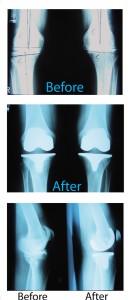The operation (known in my family as the Big O) is now nearly five months in the rear view mirror. I’m walking normally, without pain for the first time in nearly three decades, and formal rehabilitation has ceased ahead of schedule. It’s an appropriate time to put a bow on and take a bow toward the experience. It’s a laudable compliment to the orthopaedic surgeons at Mid State Orthopaedic and Sports Medicine Center that the results of the surgery are routinely successful. They have collectively performed thousands of knee replacement procedures, and the operation is becoming even more common. Still, this remains a major event for the patient.
From the start, there were two primary motivating factors in my decision to undergo the surgery. The first was the need to cut out (bad pun, I know) the ever-present pain from bone-to-bone contact. It was the kind of pain that prevented standing for more than a minute or so, that required a flexing routine before rising from a sitting position, and would frequently interrupt sleep. Here is a succinct but complete report on the pain—it’s gone…period. It’s a very happy ending.
The other factor, which has become even more important now that I’m taking for granted a normal pain-free status, was a return to an active lifestyle. I talked to many Mid State Orthopaedic knee-replacement patients prior to surgery—some for testimonials to be used in marketing and some for personal fact-finding with regard to my surgery decision. It was the joy that these patients said had returned to their lives that made a lasting impression.
They had re-engaged their life. Some in golf or tennis, or walking or even jogging (although the doctors don’t necessarily recommend the latter). Others, with a heavy flavor of South Louisiana in their constitution, reveled in their ability to return to the dance floor. For others it was gardening, cooking, playing with the grandchildren or retirement traveling. In short, the activities that brought them pleasure in daily living had been reintroduced.
I enjoy participating in some of the above, although my wife will certainly provide a disclaimer to the dance part. The specific activities that served as a benchmark for me were duck hunting (including resumption of the training of my Labrador retriever or vice versa) and fishing. In recent seasons, maneuvering in the mud and extricating myself from duck blinds has been miserable, not to mention the comic relief it provided to my hunting partners. So, it was a teal hunt with the folks at Louisiana Delta Plantation in September, at only three months post-surgery, that proved the physical and psychological worth of the operation. There was the almost mandatory descent into the Catahoula Lake muck, of course, but this time it didn’t require four burly hunting companions and a tractor to get me upright. Just a couple of days later, I handled with heretofore unknown stability being pitched around in high waves on a Big Lake speckled trout fishing trip. These two excursions were the tests I needed, and I graded an “A.”
Based on a long build-up to the actual surgery and the experience afterward, here are some recommendations from my personal viewpoint:
- Make sure that your orthopaedic surgeon is undeniably qualified to perform the surgery and committed to your success. I came across people in rehabilitation that had experienced “mistakes” in surgery, and the results were debilitating.
- Don’t commit to the surgery until the pain becomes unbearable, or the doctor tells you that you’re doing yourself irreparable harm. Years ago, my doctors told me that I would tell them when the surgery was necessary, and they were correct.
- Be aware that even though knee replacement is considered “routine” these days, it is still a major operation and will have a significant impact on your body and mind.
- Be committed—absolutely committed—to physical rehabilitation. If you aren’t, do not have the surgery. A week post-surgery in a hospital physical rehabilitation unit is highly recommended by me if your insurance allows it. Be prepared for three months, and often more, of outpatient rehabilitation following that.
- Prepare yourself for a return to a pain-free, active lifestyle. It won’t come easily, but it’s there available to you!










